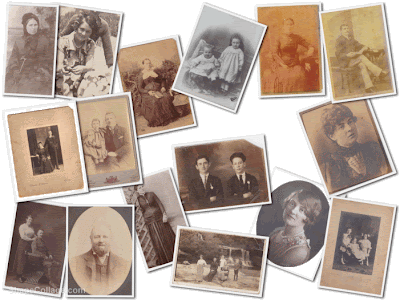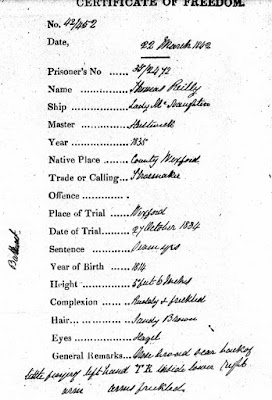Very exciting! After many years of searching for records of my convict ancestor in his home town of New Ross, Ireland, in the wee hours of yesterday morning, I finally found a description of the crime he committed in 1834 that earned him a place on a convict ship the following year, bound for Australian with one of his mates. Unfortunately, he wasn't a close-to-innocent type. With the help of two mates, it looks like he broke the jaw of an army officer (British?) by throwing a stone at him. Can't say I'm proud of what he did, but I'm very pleased to have found a record of it, thanks to Irish newspapers being online via FindMyPast.
According to articles published in November 1834, Thomas Reily committed the crime on the outskirts of the town of New Ross, with some of his mates, on Monday 11 August 1834. Thomas and his mates apparently threw a stone at Private Treleaver and broke his jaw. However, it appears that there were some rumours that Private Treleaver had been murdered. The following article notes that he was not murdered; he was injured and was recovering in the Waterford Hospital.
Town of New Ross, photographs taken in July 2012
From the article below, I found out that:
- The assault on Private Treleaver happened before the execution of Meany, at Shamboe. I'm not sure who Meany was or why he was mentioned in this article.
- Thomas was described as being in a group of "four young men of loose character".
- Private Treleaver was injured to the extent that he needed hospital treatment.
The Pilot, 27 August 1834, page 3
Transcription:
We are happy to state, that, on inquiry relative to the statement of the murder of a soldier at New Ross, we find that no such thing had occurred. The following is the incident which gave rise to the mistake: - On the evening of Monday week, previous to the execution of Meany, at Shamboe, Private Treleaver, of the 32d Regiment, was in company with a female in a field adjoining that town, when he was assaulted by four young men of loose character, who threw a stone, which struck him in the mouth, and severely injured him. He is now in hospital at Waterford, and is in an improving condition. - Waterford Mirror
A couple of months later, the report of the assault on Private Treleaver was reported on page 2 of The Waterford Mail on Wednesday 5 November 1834.
Transcription:
At the New Ross Quarter Sessions, on Saturday 25 October, Thomas Reily, Patrick Daily, and Patrick Spruhan, were tried and convicted for assaulting a Private Treleaver, of the 32D Regt. On the evening of Monday, the 11th August in the outlets of New Ross, by throwing a stone which fractured the prosecuto's jaw. Reily and Daily were sentenced to be transported for seven years and Spruhan to be imprisoned and kept to hard labour in the jail of Wexford for 9 months.
From the article above, I found out that:
- Thomas spelled his surname, Reily, which is often the way it was spelled in his Australian records.
- Thomas' mates were Patrick Daily and Patrick Spruhan. They threw a stone at Treleavar which fractured his jaw.
- The assault took place on Monday 11 August 1834, on the edges of the town of New Ross.
- Thomas and Patrick were tried for convicting Private Treleavar and were sentenced to transportation for 7 years.
- Spruhan was sentences to 9 months of hard labour at Wexford jail.
The crime and its outcome was also reported on page 1 of The Tipperary Free Press on Saturday 8 November 1834.
Transcription:
At the New Ross Quarter Sessions, on Saturday 25 October, Thomas Reily, Patrick Daily, and Patrick Spruhan, were tried and convicted for assaulting a Private Treleaver, of the 32D Regt. On the evening of Monday, the 11th August in the outlets of New Ross, by throwing a stone which fractured the prosecuto's jaw. Reily and Daily were sentenced to be transported for seven years and Spruhan to be imprisoned and kept to hard labour in the jail of Wexford for 9 months.
Thomas' trial for assault in Wexford took place on 27 October 1834. Wexford is about 40km away from the town of New Ross, where the crime was committed. He seems to have been tried alongside Patrick Daley. Both were charged with assault, both tried on the same day, and both were from Wexford. Both were given 7 years as their sentence and both tattoos.
Wexford Courthouse, photographs taken in July 2012
Wexford town, photographs taken in July 2012
Both Patrick Daley and Thomas Reilly are listed together on the list of convicts who travelled on the Lady McNaughten ship to Sydney.
Thomas received his certificate of freedom on 22 March 1842.
His mate, Patrick Daley, received his Certificate of Freedom on 3 September 1842, a few months after Thomas Reily received his.







































